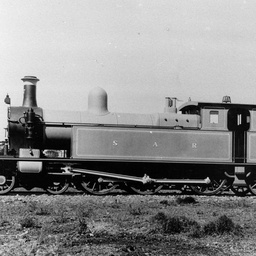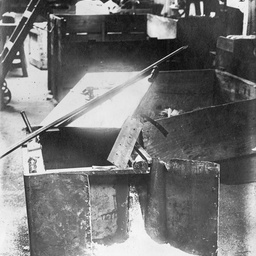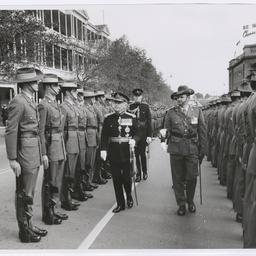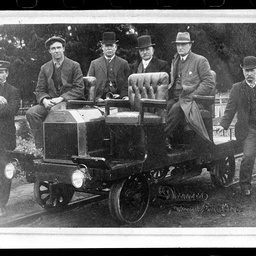Find • SOUTH AUSTRALIAN RAILWAYS • Results 481 to 510 of 811


S.A.R. Hospital Car number 76
South Australian Railways Hospital Car number 76


S.A. Gas Company Truck
S.A. Gas Company truck, which was a South Australian Railways coal truck, at Bowden.


S.A. Gas Company Truck
S.A. Gas Company truck, which was a South Australian Railways coal truck, at Bowden.


S. A. R. sleeping car
South Australian Railways sleeping car.


South Australian Railway 167 locomotive
A full side view of SAR 5'3" ga. 4-6-2T loco, No. 167.


J.F. Lewis
Photograph of Mr J.F. Lewis wearing his porter's uniform for the South Australian Railways. His identification number on his lapel is 1359. He is wearing his Porter's cap and a fob watch. The photograph was taken in the studio in Mount Gambier in 1950.


South Australian Railway Bus
Photograph of a parked bus from the SAR Passenger Service, Mount Gambier to Naracoorte.


Interior of a shed
Crates and overturned metal receptacles on the floor of a large shed, purpose not known but possibly associated with the South Australian Railways.


A locomotive with rolling stock containing carts
A South Australian Railways locomotive with rolling stock containing carts for use during World War I.


South Australian Railways locomotive
A stationary 179 locomotive, narrow gauge "Y" class S.A.R no. 179.


Distant view of Wallaroo jetty where two cargo ships and a grain ship are anchored
Distant view of Wallaroo jetty where two cargo ships and a grain ship are anchored; South Australian railway trucks loaded with produce wait in the foreground.


SAR 509
South Australian Railway 500 class Mountain steam locomotive, number 509. It was built by Armstrong Whitworth, serial number 633-642.


F class locomotive No.181
Half-plate glass negative of 2nd F class locomotive No.181 decorated for royal train July 1920.


L class locomotive No.39
Half-plate glass negative of South Australian Railways L class locomotive No.39.


E class locomotive No.49
Half-plate glass negative of South Australian Railways E class locomotive No.49 at the Port Adelaide locomotive sheds.


R class locomotive No.92
Half-plate glass negative of South Australian Railways R class locomotive No.92.


N class locomotive No.52
Half-plate glass negative of South Australian Railways N class locomotive No.52.


600 class Pacific type locomotive
Half-plate glass negative of South Australian Railways 600 class Pacific type locomotive hauling the 'Melbourne Express' over the Mount Lofty Range for the first time on 25 August 1926.


Peake Baptist Church
The Peake Baptist Church, originally built by Moore and Trezise in 1908 as a bakehouse and refreshment rooms to serve railway passengers. The building was purchased by the Home Mission Department in 1922 to serve as a new Baptist church and manse.


Opening of Parliament
Opening of Parliament: Inspection of the Guard by Sir James Harrison (Governor), outside Parliament house on North Terrace, looking towards the Railway Station.


S.A.Brewing Company
S.A. Brewing Company's bonded and free store, St. Vincent Street, Port Adelaide. The premises are about 200 yards east of the Dock Railway Station and were built in 1850 by George Coppin. Coppin was a comic actor, entrepreneur and politicican and built The White Horse Cellars, a hotel and theatre in Port Adelaide.The foundation stone for the theatre was laid in 1850. After losing his patrons to the gold rush to Victoria he became insolvent. He returned from Victoria in 1853 and paid his creditors 20 shillings in the pound.


Locomotive
[General description] This new 600 class locomotive was probably one of a batch of ten which arrived in Adelaide in 1926 and went into service that year. These were part of larger order for thirty modern steam locomotives placed to Armstrong Whitworth in Great Britain in 1924. South Australian Railways (S.A.R.) owned twenty Pacific type locomotives. [On back of photograph] 'Pacific type of locomotive'.


Mikado Locomotive
[General description] This is a new 700 class Mikado type locomotive. The two men at the cab window are possibly the engineer and fireman. This locomotive was part of an order of thirty placed by South Australian Railways (S.A.R.) with Armstrong Whitworth in Great Britain in 1924, which arrived in two shipments in 1926. These massive locomotives were unloaded at Port Adelaide and taken off the pier by horse teams. [On back of photograph] 'Mikado type of locomotive'.


Mountain Locomotive
[General description] This is a new 500 class Mountain type locomotive. It was part of an order of thirty locomotives placed by South Australian Railways (S.A.R.) with Armstrong Whitworth in Great Britain in 1924, which arrived in two shipments in 1926. These massive locomotives were unloaded at Port Adelaide and taken off the pier by horse teams. The 500 class was rated to haul 400 tons over the Mount Lofty ranges and was the most powerful locomotive in Australia at the time. [On back of photograph] 'Mountain type of locomotive'.


Camels at Hergott Springs
Camels at Hergott Springs. Gentleman in trap (with beard) is Inspector Siggins of Water Department. Seven artesian springs were used by botanist Joseph Albert Hergott who was travelling with Stuart's expedition. The springs were declared a government water reserve in 1860. A railway was built from Port Augusta to Hergott Springs in 1881. By this time the settlement already had a butcher shop, general store and a hotel


S.A.R. Inspection Car
A S.A.R. Inspection car.


Locomotive
Class "WX" no. 18, Mt. Gambier. Acccording to a researcher, this is a South Australian Railways 'Q' class locomotive. The location looks to be the northern end of the Islington workshops.


Festivities believed to be at Quorn
QUORN: Group of people standing on a float during festivities believed to be at Quorn. The large key bears the inscription: "Australia Day Fund key to the situation". According to a researcher,the man centre of photo standing with hands clasped in dark suit and tie and wearing a South Australian Railways Ambulance badge is Cedric Gregory Henry Padget. He was a painter with S.A.R. and a longtime volunteer with S.A.R. ambulance. In 1918 he was also a Quorn City Council member.


South Australian views : Aldgate Station
Aldgate Station, Adelaide and Melbourne Railway. Showing a steam train approaching while passengers wait on the platform. Advertising can be seen on the fence.


South Australian views : No. 7 Tunnel
Entrance to No. 7 Tunnel. Adelaide and Melbourne Railway.
